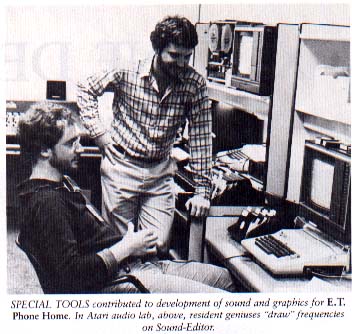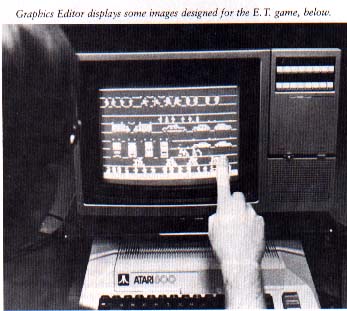E.T. GAME FOR COMPUTERS
Atari adopts America's favorite alien
by ROBERT DeWITT

The tremendous populanty of E.T., the Extraterrestrial, almost guaranteed that an E.T. computer game would appear, and such is the case. E.T. Phone Home has been released by Atari for its family of home computers. The product boasts several advances in game design, including a smooth-scrolling playfield, speedy animation of pursuers, and voice synthesis, all accomplished within the confines of a 16K ROM cartridge.
E.T. Phone Home is intended for a young market, but like the film, it may be appreciated by older players as well. The game is simple enough at the lowest level for children "Elliot's" age to play and win, but at level nine it will still challenge experienced stick twisters. The price is $49.95.
The concept of the game derives directly from the E.T. story: E.T., while hiding in the house, guides Elliot around the neighborhood to find pieces for the telephone call needed to call E.T.'s alien friends to return from space. If the pieces can be gathered within the time limit, and E.T. can scurry to the landing site without detection, the spaceship lands and carries him away.
This happy ending for the game was one of the main concerns of Stephen Spielberg, the film's producer, and is somewhat unusual, considering that most computer games have no clear ending but go on indefinitely as long as the player can endure. Spielberg took an active part in the development of the game, approving the concept, implementation and design at several stages.
Atari acquired the E.T. rights at least partly because of Spielberg's fascination with Atari products -- all the way from coin-op arcade machines to the ATARI 800, which he owns and uses. One other ingredient was the interest of Steven Ross, Chairman of Warner Communications, in associating E.T. with the Atari label.
Work on the E.T. computer game began in October 1982, according to Chris Horseman, V.P. for Software Engineering with Atari's Home Computer Division. The challenge was to move the project quickly from proposal to market while maintaining qualities required by Spielberg. These included high standards of graphic and sound representation, especially for the E.T. figure and voice, and a natural yet playable game concept that was true to the feeling of the film.
Time was important because Atari hoped to use E.T. Phone Home as a key demonstration product for the new 1200XL computer, that was to be unveiled at the Consumer Electronic Show in Las Vegas last January. Such a short fuse for a major product is practically unheard of, but a playable version was demo-ed at CES. Final play-testing and minor modifications followed.
To meet this schedule, Atari applied the team approach, essentially for the first time with a computer game. Previous Atari game products, while benefitting from the input of various specialists, had been developed by a single programmer. E.T. enjoyed the attentions of graphic artists, play designers, sound engineers, and programmers teamed up under guidance of the Manager for Entertainment Software Products.
There were more ideas for E.T. than ROM space could handle, according to Horseman, and the finished game represents only about one-fourth of the game scenario considered at different times during development. Even so, the game is elegant and sophisticated in its appearance and play. The playfield scrolls to reveal a suburban neighborhood of streets and houses edged by forests, fields and streams. These elements were constructed from characters carefully redefined so that each might contribute to several different final forms.

The "enemy" pursuers in the game are animated, and guided by routines that hunt for Elliot and E.T. under certain circumstances. This contrasts to the usual method of representation where the opponent figures do not change in appearance and move in random or predictable ways. E.T. himself is designed so that he is unmistakably recognizable in appearance and gait frontally and in profile, even though represented by relatively few pixels on the screen.
Digital synthesis of E.T.'s voice is heard at the point in the game when all the phone pieces have been collected, and although voice synthesis is not new, this is the first it has been incorporated in a ROM game cartridge for these computers. The short phrase "E.T. phone home," required more than 1,000 bytes of memory to accomplish.
The sound work for E.T. also included music and a tone (representing E.T.'s telepathic signal) that guides Elliot in his search for phone parts. The Atari sound lab is well equipped with instruments and apparatus to create almost any imaginable sounds, but the star performer is a sound-editing program with which you can "draw" the frequency profiles of the four ATARI voices, and then literally "see" what you are hearing. This development tool, and its companion graphics editor are not available to the public.
More than likely we will see more Atari products tied with popular films, TV and cartoon personalities. Projects to create gameware around such properties are underway, but that does not mean an end to original and innovative games like Star Raiders, Pac-Man and Centipede. Atari has set up an Advanced Game Design unit, and according to Horseman is actively seeking game creators who already have some notches on their joystick. Qualified applicants can contact him directly at Atari's Sunnyvale headquarters.